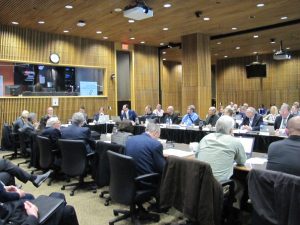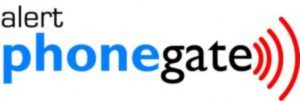Phonegate Alert submits new comments on the peer review of the National Toxicology Program’s draft technical reports on cellphone radio-frequency radiation.
In March 2018, the external peer scientists reviewers strengthened the conclusions of the NTP reports that found clear evidence of health harm from exposure to cellphone radiation in rats. The scientific knowledge of the potential impacts of cellphone radiation on our health and the health of our children should no longer be ignored. Especially in the context of a complete bankruptcy of the international regulatory system at the origin of the Phonegate health and industrial scandal.
Comments by the “Phonegate Alert” Association for the 20 June NTP meeting agenda item: Studies of Cell Phone Radiofrequency Radiation Report on the 26-28 March 2018 Peer Review of NTP Technical Reports

Following the oral presentation and written comments addressed by the Association “Phonegate Alert” to the 26-28 March Peer Review meeting of the National Toxicology Program study on rats and mice exposed to cell phone radiofrequency radiation, we wish to inform you of further developments.
As you will recall, after many legal actions of our Organization, the French National Frequencies Agency (ANFR) released the first set of data in June 2017 and the report in March 2018 on the results of tests conducted on mobile phones which revealed that 9 out of 10 phones tested by the Agency in 2015 in contact with the body showed a Specific Absorption Rate (SAR) value higher than the European regulatory threshold of 2W/kg, and 1 out of 4, a SAR value higher than 4 W/kg.
Since the transposition into French law of the European Directive RED 2014/53/EU in June 2017, ANFR can impose administrative sanctions on devices exceeding the SAR regulatory threshold, including administrative fines, requests for withdrawal from the market and recall of devices already purchased. Measurements are carried out at an accredited laboratory in order to verify the compliance of selected mobile phones with the new European requirements concerning the SAR “trunk”. These requirements have been progressively applied in France since 25 April 2016. All devices placed on the market after this date are evaluated at a maximum distance of 5 mm, instead of 15 to 25 mm previously. The ANFR test results for 450 mobile phones are posted on its data site: SAR Data Since June 2017, we have written three times to the French Minister for the Ecological and Inclusive Transition, Mr. Nicolas Hulot and to the Minister for Solidarity and Health, Mrs. Agnès Buzyn asking them to inform consumers, launch prevention campaigns and to have more than 206 mobile phone models withdrawn due to their health risk.
In this context, on 5 April 2018, ANFR announced the first withdrawal, by way of exchange, by the mobile company Orange of 90,000 mobile phones of the « Hapi 30 » model manufactured by Mobiwire. Measurements revealed that the SAR regulatory limit of 2 W/kg for the trunk was exceeded by 0.1 W/kg, i.e. a measured value of 2.1 W/kg on the rear of the telephone.
This was followed by the withdrawal and updating of four new smartphones exceeding the 2 W/kg SAR threshold for the trunk in order to ensure compliance. On 29 May 2018, in a first press release, ANFR announced the withdrawal from the market of the NEFFOS X1 TP902 phone imported by TP-Link France and stated: “The measurements revealed that the regulatory limit of 2 W/kg (Watt per kilogram) had been exceeded by 0.52 W/kg, i.e. with a value of 2.52 W/kg on the rear of the telephone”.
In a second press release appearing the same day, ANFR announced having requested the updating of three phones of the brands Alcatel PIXI 4-6 », Echo Star Plus and Huawei Honor 8.
Téléphone Alcatel PIXI 4-6’’ (Constructor: TCL)
Initial value: System version: 01001 SAR “trunk” measured: 2.04 W/kg
Value after update: System version: 01005 SAR “trunk” measured: 1.58 W/kg
Telephone Echo Star Plus (Constructor: Modelabs Mobiles)
Initial value: System version: V01_20170630 SAR “trunk” measured: 2.05 W/kg
Value after update: System version: V02_20180307 SAR “trunk” measured: 1.41 W/kg
Telehone Huawei Honor 8
Initial value: System version: FRD-L09C432B131 SAR “trunk” measured: 2.11 W/kg
Value after update: System version: FRD-L09C432B394 SAR “trunk” measured: 1.45 W/kg
Of the 443 mobile phones tested by ANFR between 2012 and 2017, only 273 were tested at 0 mm from the skin. 206 of the 273 tested at 0 mm exceed the regulatory threshold of 2W/kg. Of the 129 tested at 0 mm and 5 mm, 19 exceed at 5mm the 2W/kg threshold and 33 at 0mm the 4W/kg threshold.
Many phones tested by ANFR thus exceed the SAR regulatory limits, some reaching, in terms of the European standard, more than 7 W/kg, or, recalculated according to the U.S. standard, more than 20 W/kg, that is, exceeding ten times the threshold, posing a risk to the health and safety of users. According to Professor Om Gandhi, one of the designers of cell phone radiation testing, if the ANFR test results were applied to the United States, cell phones would exceed the regulatory limits. For example, for the Apple iPhone 5, the SAR test trunk result at 0 mm from the skin is 5.32 W/kg for Europe.
The levels of radiofrequency radiation to which millions of people are being exposed is greater than that used in the NTP studies (whole body SAR), particularly the one on rats, where study results indicated the appearance of tumors or pathologies at SAR level exposures of 1.5, 3.0 and 6.0 W/kg for rats. Many of the mobile phones tested by ANFR are today still among the best-selling ones and used by millions of people in France, “tens of millions in Europe, hundreds of millions at the international level, including children. It is a major public health issue that should be dealt with responsibly by authorities worldwide, starting with campaigns for safer mobile phone use. Robert Genet, Director-General of the French National Agency for Food, Environmental and Occupational Health and Safety (ANSES), had recommended to the French public authorities in his July 2016 report, “Exposure to Radiofrequencies and Child Health”:
– “Re-evaluate the pertinence of the specific absorption rate (SAR) used in the establishment of limit values of exposure of people for means of protection against known and proven health effects (thermal effects) of radiofrequencies.”
“Develop a measurement representative of the actual exposure of users of mobile phones, no matter what the conditions of use: signal used, good or bad reception, type of use (calls, loading of data, etc.)”
– “Ensure in all circumstances the respect of regulatory limit values of exposure, no matter what type of emitting devices are used and their conditions of use (positioning in contact with the body).”
Finally, in March 2018, with Dr. Devra Davis of the Environmental Health Trust, we wrote to the FCC asking them in turn to intervene to make U.S. regulations stricter to better protect the health of users of not only mobile phones but also tablets and connected objects, and especially, in the context of the results of the NTP study which shows the existing links with various pathologies including cancers associated with 2G and 3G mobile phone radiation. To date, we have not received a reply from the FCC.
Dr. Marc Arazi President Phonegate Alert www.phonegatealert.org

Phonegate Alert Comments on Peer Review of NTP’s Draft Technical Reports on Cellphone Radiation
